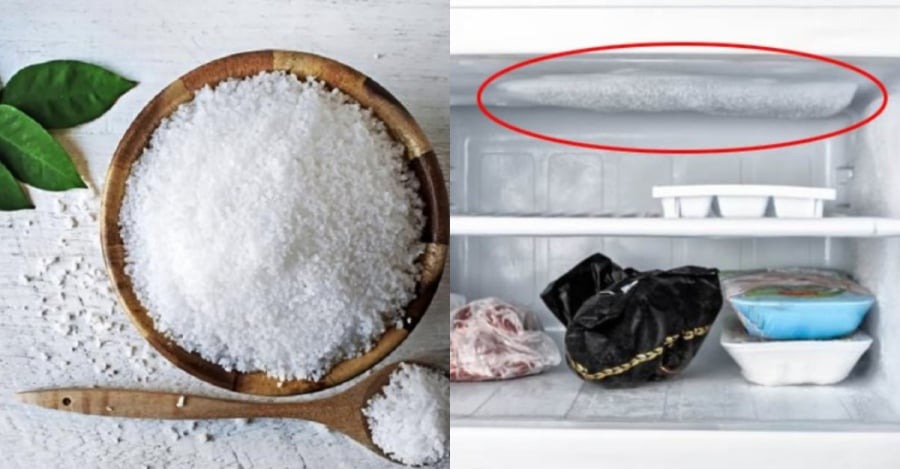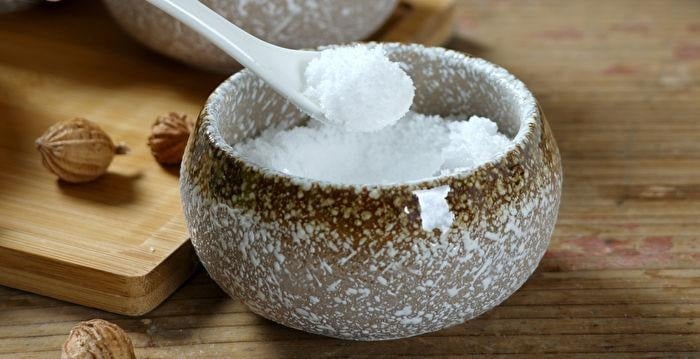Sprinkling salt in the fridge is a good way to eliminate bacteria and remove unpleasant odors.
Softening stains quickly, cleaning the fridge
Quickly softening stains and cleaning the refrigerator sometimes becomes an important task to ensure food hygiene and safety. The fridge is a place that stores a variety of food, from raw to cooked, and hence, regular cleaning is essential.
There are many methods to clean the fridge, and a simple yet effective way is to wipe it with saltwater. Instead of just using water, adding a bit of salt to the cleaning solution can enhance its disinfecting ability and soften stains. To further boost effectiveness, you can add vinegar or lemon juice to the cleaning solution.
Maximize odor removal in the refrigerator to keep food fresh longer
Salt, white vinegar, and lemon all have properties that eliminate odors, act as antibacterial agents, and help soften stains quickly. Thanks to these characteristics, cleaning the refrigerator becomes easier, stains are effectively removed, and bacteria are killed, making the refrigerator clean and fresh-smelling.

The cleaning process is extremely simple: prepare a mixture of warm water, salt, and lemon juice or white vinegar. Then, use a cloth soaked in the solution to wipe the inside surfaces of the refrigerator.
You can also put the solution into a spray bottle and spray it onto the areas that need cleaning, then use a cloth to wipe them dry. To eliminate odors, placing a bowl of salt inside the fridge is also an effective method, not only keeping the refrigerator clean but also preserving food better.
Defrosting the ice in the freezer compartment
Defrosting ice in the freezer compartment can affect the cooling efficiency and food storage in the fridge. If the fridge temperature is set too low for an extended period, a layer of ice will form around these areas, posing a risk of damaging the fridge when using sharp objects to remove the ice.
A simple method to tackle this issue is by using salt and warm water. Here is the process:
Turn off the power to the refrigerator for safety and energy saving. Then, move the food and other items out of the fridge.
Prepare a jar of warm water (around 50 degrees Celsius), add a bit of salt, and shake well until the salt is completely dissolved.
Use a plastic bottle, spray the saltwater onto the ice layer in the fridge by firmly pressing the bottle cap to create multiple small holes. Before doing this, you can place a cloth or a mat around the fridge to absorb the flowing water.
Additionally, you can directly sprinkle salt onto the ice layer to speed up the thawing process efficiently because salt has the ability to absorb water. Once the ice layer has melted, use a clean cloth to dry the fridge, and it will become clean and operate more efficiently.
Besides solving the issue of ice build-up in the fridge, salt has various other applications such as repelling ants, cleaning shoes, reducing itching from mosquito bites, cleaning cutting boards, and solving many other daily life issues.
Other uses of salt:
Repelling ants
Ants can create nests and crawl inside the house, making you uncomfortable. Use saltwater to spray in all the areas where ants gather or congregate.

You can also draw chalk lines to repel ants. However, this is not a good option because you have to draw a thick line of chalk on the areas where ants pass through. Another method is to put lavender flowers or spray various types of essential oils in areas where ants gather.
Removing shoe odor
Put salt in a small bag (made of fabric or paper towels) and place it inside the shoes regularly when you are not using them (preferably overnight). You can also combine salt with baking soda for better results.
Reducing itching from mosquito bites
Mosquito bites cause itching and discomfort. Apply a little salt to the affected area to reduce itching and prevent mosquitoes from biting there again.
Cleaning cutting boards
There are many bacteria and germs on the cutting boards even if you wash them thoroughly after each use. You should clean the boards more often, especially wooden cutting boards. Use 4 parts baking soda and one part salt for scrubbing. Then, rinse with water and pour this mixture onto the cutting board, leave it for about 30 minutes to an hour, and then rinse thoroughly.
Most experts recommend cleaning the cutting boards thoroughly at least once a week.
Making toothpaste
This is a way to make natural, safe, and cost-effective toothpaste. Table salt, baking soda, and a little water are the secret formula for making toothpaste easy. This mixture works like regular toothpaste.
Additionally, use saltwater to rinse your mouth after brushing to fight against all types of bacteria, helping balance your mouth’s bacterial system.
Treating dandruff
Salt absorbs excess oil and removes dandruff from your hair wonderfully. Spray a little saltwater onto your hair and leave it for a few minutes, then wash your hair as usual. You can use honey as a substitute for salt. Mix a teaspoon of honey with a little warm water, then massage your scalp thoroughly and wash it well.












